The Mayflower Plate: Today and Yesterday
- lesterandconnie
- Sep 18, 2021
- 4 min read
Updated: Nov 11, 2023
We only have Edward Winslow’s reference to what was served that first Thanksgiving in 1621, and nothing about what it was served on. The menu evolved if not solidified over the years since becoming a regular United States holiday in 1863, the setting then visually if not eternally etched in American consciousness as “Freedom From Want”, third of the Four Freedoms series of four oil paintings by American artist Norman Rockwell. The works were inspired by President Franklin D. Roosevelt’s 1941 State of the Union Address, known as “Four Freedoms.” As such, it was never a cover of the Saturday Evening Post (published in March 1942) as were so many of his holiday-specific depictions which have never eclipsed this image of the quintessential Thanksgiving. While the turkey seems locked in by this date, Rockwell takes no position on the table setting, preferring a neutral white so as not to upstage the assembled.

Growing up in Colorado, my mother put great effort into memorable table settings, which were never the same year to year, since the menu was fixed. It certainly was never neutral and featured whatever inherited ancestral table service fit the guest list. These variations to a great degree defined the event and when tied to specific conversations and current events, are vividly recalled to this day.
On my own years later in New York City, with dishware decidedly white and modern, and about the time I discovered my descendancy from Mayflower passengers (entirely unbeknownst to my parents), I came upon a heraldic Mayflower plate for sale during a browser search. What an oddity, produced in the vivid blue of ever-popular English “transferware,” the Mayflower ship darkly depicted within and surrounded by family crests for Alden, Bradford, White, Winslow, Howland, Fuller, Warren, Brewster, and Standish. As I descend from most, I bought it immediately and for peanuts. I thought it might add to my own holiday setting the historical and aesthetic element that harkened to my childhood, while bemusedly celebrating newly discovered ancestors in an offhanded way -- neither challenging my purist aesthetics nor making too big a show to guests. Then it arrived. It was far more interesting than advertised.
A search of what other “Mayflower Plates” were out there ensued, and I was able to deduce several types of varied vintages and styles. Here are some of them, and I wonder how many more there are:
Heraldic
My small 1909 plate (Rowland & Marsellus Co., Staffordshire for A.S. Burbank, Plymouth, MA) is one of several of this type and era, coinciding with the turn-of-century burgeoning interest in early American ancestry – newly formed lineage organizations such as Daughters of the American Revolution (DAR), founded in 1890, and our own GSMD in 1897, for example. While commercially produced for the American market, its design was intended to comfortably sit astride the everyday tableware of the average home. The concept has remained and been updated right up to today.
Souvenir and Cabinet
Technically, my heraldic plate is a souvenir intended for Plymouth’s visitors. But there are several more overtly so, with no intention of fitting in or used beyond display. The latter were known as “cabinet plates.” Their supply and subject have been constant for over a century -- an unintended representation of changing graphic styles and taste through the years, transferware to “Depression glass”.
Full Sets
Full sets may predate the one-off souvenir, typically characterized either by a full range of pieces (single service and pattern), or a series of just dinner or dessert plates with multiple images. English manufacturer Crown Ducal excelled in its variety of transferware shapes, colors, and between World Wars I & II. Popular subjects of the Pilgrim experience were “The First Sermon Ashore,” “Courtship of Miles Standish,” “Signing the Contract in the Mayflower” among others. As an offshoot, there were many hotels named “The Mayflower” with custom tableware still findable.
Commemorative
Anniversaries of the Mayflower landing were obvious dates for issue, but unusual plates were also issued commemorating everything from the sailing of “Mayflower II” in 1956 to a unique plate issued for every presidential inauguration celebrated at the Mayflower Hotel, Washington, D.C.
International Touchstones
The locational touchstones surrounding the Mayflower voyage, both Plymouths (Dover and Massachusetts) as well as Leiden, have issued plates through the years – more often as not to commemorate an associated local event or even a passenger, such as the 1979 Millennium of a place merely cited in the will of Myles Standish, and not his proven birthplace: Tynwald, Isle of Man.
Limited Editions
With the popularity and commercial viability of the Mayflower plate well established, artisan limited editions began to emerge in the 1970’s – both anticipating and following the well celebrated Bicentennial of the United States. Coalport China hired artist Donald Brindley to design a plate for the 350th anniversary “of the sailing of the Pilgrim Fathers,” each numbered and limited to a production of 1,000 – the ship unusually flanked in cherubs.
Provincial
Like fashionable design movements that came before, there is no greater proof of the commercial viability of the type as historic icon than production of the Mayflower plate in countries entirely disconnected from the event. Japan, Israel, Portugal, Argentina, for example. The charm in provincial production is the inevitable misinterpretation of the facts -- as with a Chinese plate entitled “Mayflower” but featuring three ships looking a lot like the Nina, Pinta, and Santa Maria.
While my mother’s several sets of ancestral fine china have indeed made it to Australia, they’ve been usurped. Nothing has surprised me more since collecting than the expressed preference of expected guests, “Oh, can I have this or that plate Mayflower plate at my seat?”







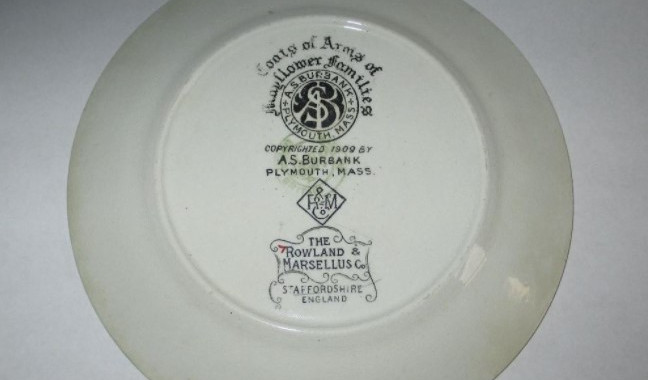


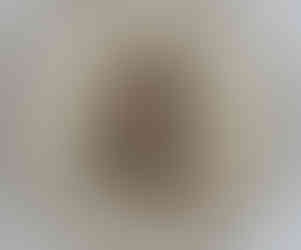


















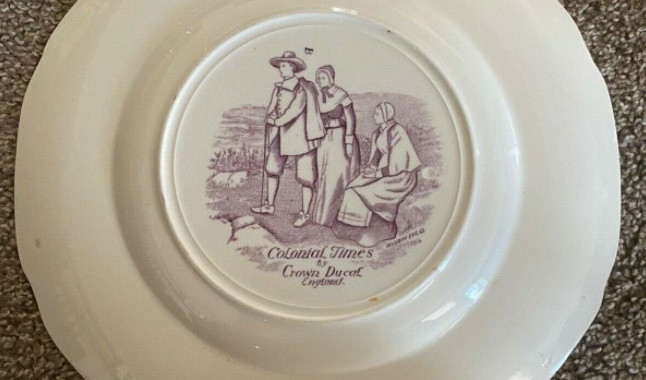



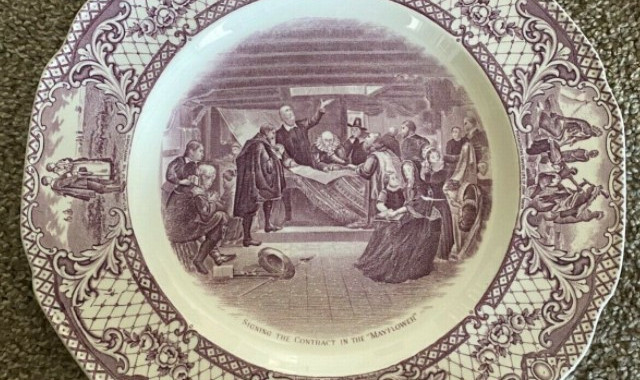









































































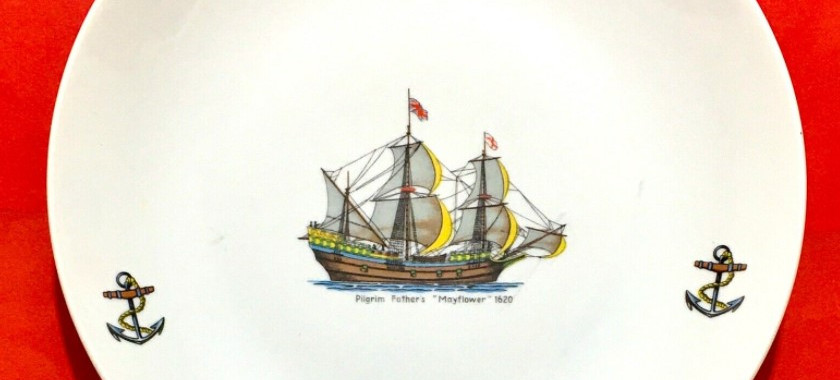






Comments